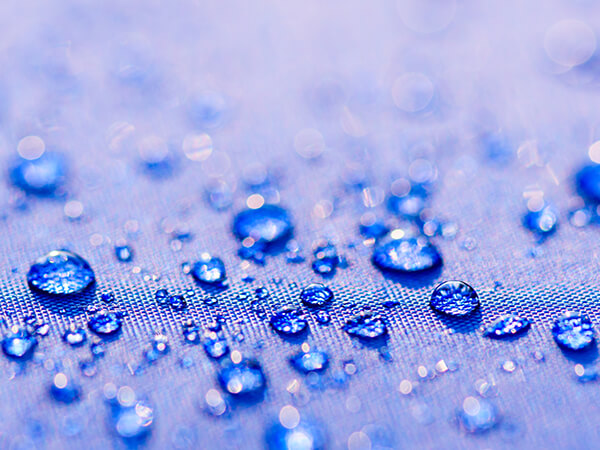
Innovative and ecological methods to manufacture waterproof and breathable membranes
By Laura Solomon
For outdoor enthusiasts, having the right clothing is essential to maintain thermal comfort outdoors, especially in a wet, windy and cold environment.
For outdoor enthusiasts, having the right clothing is essential to maintain thermal comfort outdoors, especially in a wet, windy and cold environment. Water resistance is a fundamental function of any outdoor or sportswear garment to ensure the body stays dry.
For a person to feel comfortable in outdoor environments, it is vital that the energy produced and exchanged with the environment is evenly balanced. The human body must maintain its core body temperature of 37°C, to ensure the body feels comfortable and maintains well-being. The body maintains a comfortable temperature during different levels of exertion and environmental conditions, through changes in blood flow and evaporation of perspiration from the skin’s surface as it naturally tries to cool itself down [1]. However, as the body has a limited ability to cope with the outdoor climate, functional materials are selected and engineered for use in outdoor apparel to provide comfort and protection from otherwise uncomfortable environments.
Clothing designed to keep a wearer dry is typically made from either permeable (breathable) or impermeable (non-breathable) textile materials. Impermeable water-resistant materials are notorious for being excellent at blocking water molecules from entering through the membrane. However, it is this same mechanism that often makes these materials uncomfortable to the wearer. This is because excellent resistance to water molecules from the outside environment means that water vapour molecules produced from the body’s perspiration cannot escape from inside the microclimate between the skin and the clothing. Therefore, because perspiration can’t escape, wearing impermeable waterproof textiles commonly causes the wearer to become stuffy and wet with sweat, and subsequently can cause the wearer to experience cold chills.
Permeable textiles, also referred to as waterproof-breathable membranes, prevent liquid water permeating the material. However, they allow water vapour and sometimes air to pass through, maximising comfort and dryness during outdoor activities [2].
Breathability in outdoor garments is extremely important to prevent the wearer overheating, as well as for keeping both the wearer comfortable and the textile fresh by avoiding the build-up of lingering odour. Therefore, a breathable protective garment will aid to enhance sports performance by enabling the athlete to pursue outdoor physical activity of any intensity, while remaining comfortable and protected [2].
Moreover, achieving water resistance in textiles has often resulted in the use of perfluorinated chemicals (PFCs) due to their superior water, oil and soil repellent abilities. PFASs – polyfluoroalkyl substances – are also used as this group of chemicals is closely related to PFCs, with both containing fluorine and carbon atoms. However, despite their great repellent properties, both PFCs and PFASs are part of the DWR discussion that refers to concerning compounds, and they have been the subjects of severe criticism in recent years. Specifically, longer chain PFC materials, depending on their functional groups, can be very hazardous due to their harmful by-products; although it is generally understood that not all PFCs/PFASs are hazardous [3].
PFCs and PFASs can be both environmentally and physiologically hazardous. They are highly persistent molecules in nature, meaning that some of them will degrade extremely slowly or not at all, and many are also bioaccumulating. However, ironically, those who treasure the environment often wear garments that are damaging it. The majority of breathable outdoor outerwear is created with PFASs because they are extremely good at providing water and oil repellence. And although there are still no obvious alternatives to PFAS membranes for deterring oil, developments are being made for fending off water.
In this innovation profile, WTiN reports on a textile material discovered by researchers from Aalto University School of Chemical Engineering, Finland, who have developed a non-toxic, water-resistant and breathable coating solution with wax obtained from Brazilian palm tree leaves [4].
Additionally, WTiN compares the research outcome from Aalto University with a commercially available PFC and PFAS-free, water-resistant and breathable membrane technology from the company Dimpora. Dr Mario Stucki, CEO and co-founder of Dimpora, talks to Laura Solomon about the technology used within the company’s environmentally-friendly membranes for outdoor clothing.
You're trying to access an article that requires you to register and become a member.
You can start browsing without limits by taking one of our paid memberships.
-
Registered
Stay informed with limited access to global innovation news throughout the textile and apparel value chain.
The journey starts here....
- Weekly ICYMI (in case you missed it) email ? Our weekly round-up of content delivered to your inbox.
- Insight (limited) ? Feature-length articles providing significant insights into crucial industry developments, material, technology innovation and business innovation, includes direct-to-source interviews with key industry stakeholders and market roundups.
- News ? Press releases from across the global textile & apparel supply chain, bringing you all the latest developments direct from the companies involved.
- Sponsored Content ? Sponsored editorial with companies and organisations within the textile & apparel supply chain, based on company developments, product launches and key initiatives.
- Podcast ? Immerse yourself in the latest innovations and expert insights from global textile and apparel leaders—spanning Asia to the Americas—covering the full value chain from tech to manufacturing.
- Digital Journals (limited) ? Our current and archived digital journals.
-
Member
Deepen your understanding of key trends, technologies, and developments shaping the textile and apparel industry.
Everything in 'Registered' and....
- Insight (unlimited) ? Feature-length articles providing significant insights into crucial industry developments, material, technology innovation and business innovation, includes direct-to-source interviews with key industry stakeholders and market roundups.
- Watchlist ? Build bespoke email alerts using keywords, schedule frequency, and delivery timing.
- Virtual event pass (1 per member) ? Attend our virtual events that explore and celebrate innovation right across the textile and apparel value chain.
- Event reports ? Comprehensive digital event reports created after our virtual events, dive deep into key topics discussed during the event.
- Email support ? We're here to help.
-
Member Plus
Access expert analysis, actionable intelligence, and vital content to help you uncover, understand, and innovate.
Everything in 'Member' and....
- Intelligence ? Business-critical content, sometimes incorporating proprietary data and analysis, with a strategic focus on business, material and/or technology innovation. Often more in-depth and technical, this content type identifies opportunities, market shits and potential impact.
- Case studies ? Structured insights into challenges faced by manufacturing facilities and the solutions they have adopted. Each article includes business insights, problems, solutions, technologies, measurables, outcomes and learnings.
- Innovation Briefings ? Articles providing an academic and commercial perspective on key topics and innovations, including both emerging or commercially ready innovations.
- Company profiles ? In-depth reports offering structured analysis on the strategic activities of companies within the textile & apparel supply chain.
- Funding watch articles ? Monthly roundup and assessment of the past month's venture funding news within the textile & apparel supply chain, focusing on early and growth stage funding.
- Reports ? In-depth editorial reports on key sectors, events and topic. Includes insight, market-driven developments, interviews and analysis in a comprehensive, journal format.
- Pricing ? Access to our weekly EMR (Executive Market Report) and WMR (Wool Market Report) pricing reports.
- 10% discount on consultancy ? Unlock your next growth phase and discover new opportunities by leveraging our bespoke consultancy service. WTiN has been commissioned by its consultancy clients for almost 10 years, all taking advantage of our over 100 years of history in the textile & apparel industry.
- Email support ? We're here to help.
-
Member Premium
Use proprietary data tools to track, monitor, analyse and navigate industry trends and market shifts with confidence.
Everything in 'Member plus' and....
- Digital Textiles Market Tracker ? Proprietary data and analysis of global digital textiles market sales.
- Patents
- Fibres Hub ? The number of on-demand videos you can show on your booth
- Smart Textiles Database
- Additional virtual event passes ? Additional passes for your colleagues and select customers beyond the named members.
- Custom data feeds ? We can work with you do deliver our data to you in the format you need.
- 20% discount on consultancy ? Unlock your next growth phase and discover new opportunities by leveraging our bespoke consultancy service. WTiN has been commissioned by its consultancy clients for almost 10 years, all taking advantage of our over 100 years of history in the textile & apparel industry.
- Email & phone support ? We're here to help
Unlock a bespoke solution-based membership proposal, just for you...
Already have an account? Log In

